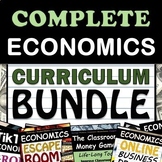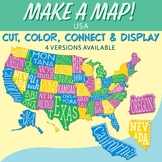29 results
Civics Common Core L.11-12.4 resources
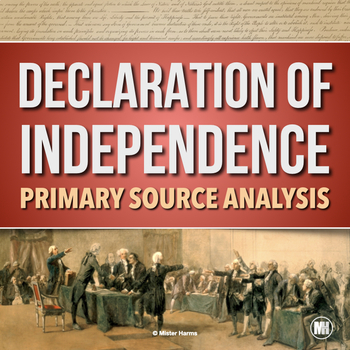
DECLARATION OF INDEPENDENCE Activity: Primary Source Analysis and Questions
The Declaration of Independence can be a daunting document for teachers to explain to students, but this primary source lesson will help students understand the major themes and concepts within the document itself. Though Thomas Jefferson's Declaration was written in the 18th century, this worksheet has proven to be a fantastic, big-picture way for today's students to study such an important writing without becoming overwhelmed. The Declaration is really just a big "break-up letter" from the co
Subjects:
Grades:
7th - 12th
Types:
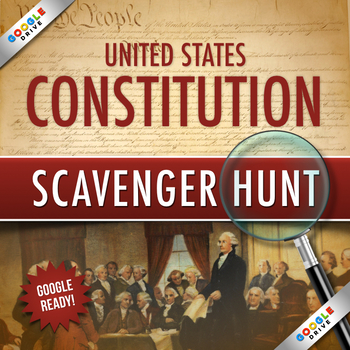
CONSTITUTION SCAVENGER HUNT: Google Drive | Google Forms | Google Classroom
To better understand the basic information within the U.S. Constitution, students will browse through this primary source document and find the main ideas regarding the 7 Articles and 27 Amendments. Included are 17 questions about the articles and 27 questions about the amendments. All questions (except for one) will be answered with a number. This is a great way to introduce, study, or review the United States Constitution for your civics unit or for a Constitution Day activity. You may even
Subjects:
Grades:
5th - 12th
Types:
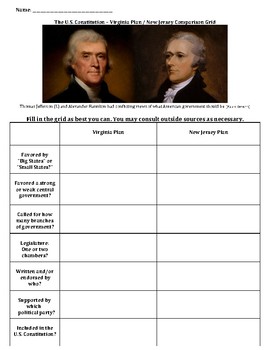
The Constitutional Convention – New Jersey / Virginia Plan Comparison Grid
When delegates from the twelve attending states gathered in Philadelphia during the Summer of 1787 (Rhode Island sent no representatives), the convention's outcome was far from certain. Its official purpose was to reform the Articles of Confederation. However, for many of the men who came, mere reforms would not be enough.This side-by-side comparison grid explores the chief ideological conflict of the US Constitutional Convention: Big States vs. Small States. By exploring the New Jersey and Virg
Subjects:
Grades:
6th - 12th, Higher Education, Adult Education
Types:
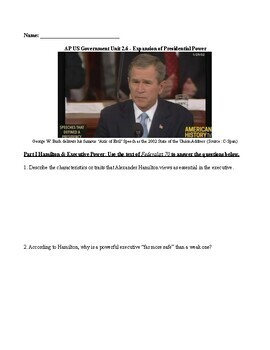
AP® US Government Unit 2.6 - Expansion of Presidential Power
Unit 2.6 of the AP® curriculum focuses on how the power of American presidents has evolved and expanded through the Republic's history.This eight-question short answer worksheet begins with an analysis of Federalist 70, Alexander Hamilton's defense of a strong executive branch, and proceeds to trace the evolution of presidential power since those words were written. Why did Hamilton believe his executive plan would be "safer?" What was the War Powers Act? Special attention is devoted to the imp
Subjects:
Grades:
11th - 12th, Higher Education
Types:
Also included in: AP® US Government - Comprehensive Full-Year Accompanying Curriculum
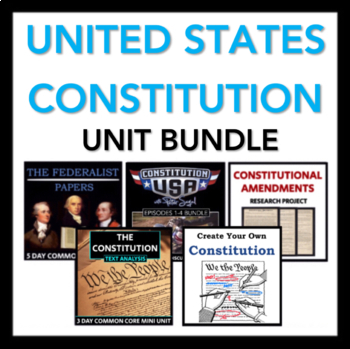
U.S. Constitution UNIT PLAN BUNDLE - 4 Weeks - Includes Pacing Guide
This unit bundle includes a variety of our engaging, best-selling resources for teaching through the Constitution of the United States, both its content as a document and its history within the early formation of the republic. These hands-on activities can engage your students throughout the span of your teaching unit. The products include worksheets, projects, primary source materials, and video guides. There is also a bonus Curriculum Pacing Guide with a suggested sequence for how you can sche
Subjects:
Grades:
8th - 12th
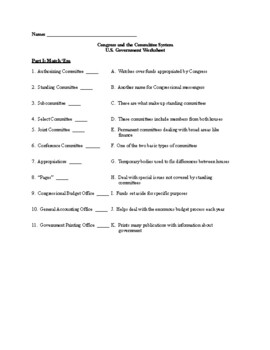
Congress: The Committee System
In order to more efficiently conduct the business of the United States, Congress divides its workload up among a variety of committees and subcommittees. As a result of this however, both the Senate and House of Representatives are home to a bewildering array of legislative sub-bodies, each with its own purpose and agenda.This 'match-em' and short answer worksheet is designed to help students navigate the complicated world of congressional committees. Using 'match-ems' and short answer questions
Subjects:
Grades:
9th - 12th, Higher Education
Types:
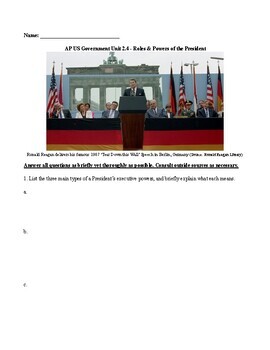
AP® US Government Unit 2.4 - Roles & Powers of the President
Unit 2.4 of the AP® curriculum focuses on executive power in the United States system of government, and how Presidents use these powers to accomplish policy goals.This six-question short answer worksheet seeks to identify the various types of executive, diplomatic and judicial powers granted to US Presidents in the Constitution, while also defining the practical implications of these powers, and their limitations. Additionally, special attention is given to an analysis of how presidential acti
Subjects:
Grades:
11th - 12th, Higher Education
Types:
Also included in: AP® US Government - Comprehensive Full-Year Accompanying Curriculum
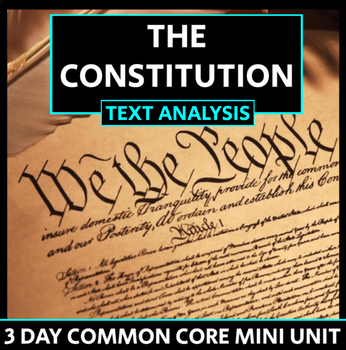
The Constitution: Text Analysis - Mini Unit, CCSS
This is a 3-day mini unit in which students analyze the text of the Constitution of the United States. This works well as a text analysis for ELA, history, or a civics classroom. Students will read the text (included), engage with the vocabulary, collaborate to answer text-dependent questions, and complete a writing assessment from a choice board. Product includes:OverviewDaily lesson plansWarm UpsExit TicketsVocabulary Preview (answer key included)Anticipation GuideThe text itself ("The Constit
Subjects:
Grades:
8th - 12th
Types:
CCSS:

Social Justice Research Project - Distance Learning
This research can be done at home or at school. It focuses on social justice issues so that students can find what they are passionate about and learn how to effectively inform or persuade others to care about it as well. I have included an "ideal" teaching guide as well as how I taught it during the hybrid model. This is the project and the rubric for the project. While I catered this to English 3 (or English 11 depending on your state), it can be used for multiple grade levels.
Subjects:
Grades:
8th - 12th
CCSS:
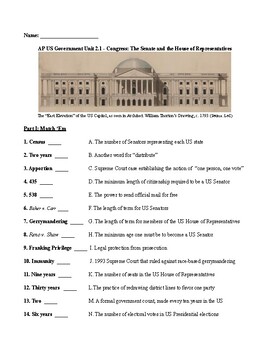
AP®US Government Unit 2.1 - The Senate and House of Representatives
Unit 2.1 of the AP® curriculum focuses on the structures and functions of Congress in the American political system. This two-part worksheet helps students understand the different compositions , powers, and day-to-day operations of both the House of Representatives and Senate. Part I is a 14-question matching exercise that introduces students to the basics of Congress, such as term lengths for each house, minimum requirements of members, and vocabulary such as "gerrymandering" and "franking pr
Grades:
11th - 12th, Higher Education
Types:
Also included in: AP® US Government - Comprehensive Full-Year Accompanying Curriculum

AP® US Government Unit 1.9 - Federalism in Action (American Federalism)
Unit 1.9 of the AP® Curriculum devotes itself to the daily practice of American federalism, and seeks to answer the following two questions: (1) based on the constitution, where does federal power end and state power begin? And (2) how does this balance impact the policymaking process?This short answer worksheet deals extensively with constitutional power, beginning with definitions of the various types of power (expressed, implied, etc.) that coexist within American government. The questions th
Subjects:
Grades:
11th - 12th, Higher Education
Types:
Also included in: AP® US Government - Comprehensive Full-Year Accompanying Curriculum
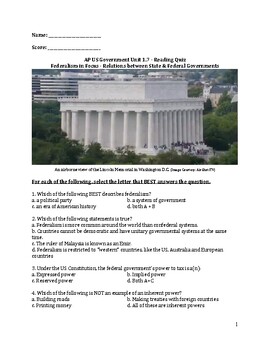
AP® US Government Unit 1.7 - Federalism in Focus Reading Quiz
Unit 1.7 of the AP® curriculum is devoted to questions surrounding the allocation of power in the US government, specifically: what is federalism, and why should we care? Where does federal power end and state power begin? And, perhaps most importantly, what role does money play in this whole process?This reading quiz is based upon "Federalism in Focus," a 2500-word essay that that is designed to help students prepare for the AP US Government Exam. The text and quiz both cover each of the foll
Subjects:
Grades:
11th - 12th, Higher Education
Types:
Also included in: AP® US Government - Comprehensive Full-Year Accompanying Curriculum
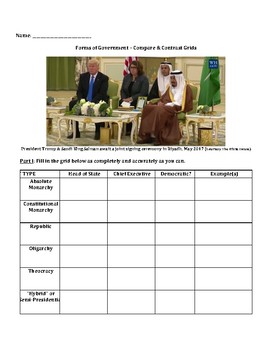
Comparing & Contrasting Systems of Government
For those of us fortunate to live under a democratic, representative system of government, it can be easy to take our country's political institutions for granted. Yet many people on Earth live under repressive, even violent, regimes, where any form of protest can lead to a lengthy prison sentence.This 'cheat sheet' comparison grid analyzes the various form of government that exist around the world - from republics to theocracies to oligarchies - and provides students with a meaningful snapshot
Subjects:
Grades:
10th - 12th, Higher Education
Types:
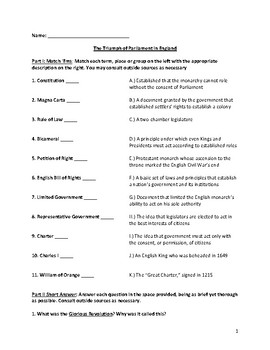
The Triumph of Parliament in England (Match 'Em & Short Answer Worksheet)
By the time they reach high school, students know that the United States was once a British colony. However, not all of them understand that seemingly American concepts, like a Constitution, Bill of Rights and the Rule of Law, all have their origins in the British Isles.Tracing Britain's evolution from absolutism to constitutional monarchy, this two-part worksheet includes historic notables such as: Charles I, Magna Carta and the Glorious Revolution. It will help deepen students' understanding o
Subjects:
Grades:
9th - 12th, Higher Education
Types:

AP®US Government Unit 1.5 - Ratification of the Constitution (Short Answer, T/F)
Unit 1.5 of the AP® curriculum emphasizes compromise & negotiation - both the compromises necessary to ratify the United States's constitution, as well as the ongoing role that negotiation and dialogue continue to play in its government.This worksheet consists of two sections, each designed to challenge and improve your students' understanding of the Constitutional Convention: Section 1 contains two short answer/identification questions about the role(s) played by the convention's main perso
Subjects:
Grades:
11th - 12th, Higher Education
Types:
Also included in: AP® US Government - Comprehensive Full-Year Accompanying Curriculum

AP® US Government Unit 1.9 - Federalism in Action (Relations Among the States)
Unit 1.9 of the AP® Curriculum devotes itself to the daily practice of American federalism, including questions about how power is shared among the states: what is the process of adding a new, equal state? What responsibilities and obligations do states have once they are admitted to the Union?This two-part worksheet traces the evolving process of statehood, and uses the constitution's own words to help further students' understanding of state-to-state and state-to-federal relations.Part I is a
Subjects:
Grades:
11th - 12th, Higher Education
Types:
Also included in: AP® US Government - Comprehensive Full-Year Accompanying Curriculum

AP® US Govt 1.7 Text - Federalism in Focus (Relations b/w State & Federal Govts)
Unit 1.7 of the AP® curriculum is devoted to questions surrounding the allocation of power in the US government, specifically: what is federalism, and why should we care? Where does federal power end and state power begin? And, perhaps most importantly, what role does money play in this whole process?"Federalism in Focus" is a 2500-word essay that is designed to help students understand federalism as they prepare for the AP® US Government Exam. Featuring photos, archival newsreel stills, and a s
Subjects:
Grades:
11th - 12th, Higher Education
Types:
Also included in: AP® US Government - Comprehensive Full-Year Accompanying Curriculum
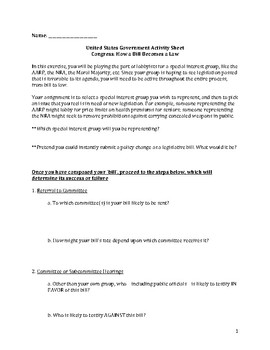
How a Bill Becomes a Law – Classroom Activity & Vocab List
Congress remains one of the least trusted institutions in the United States - some surveys even rank its members behind used car salesmen in terms of reliability.This activity packet helps students understand the legislative process, as they take on the role of imaginary policy activists and craft a 'bill' they would like to see passed. From there they follow their bill through referral and markup to floor debate and beyond. Included with the step-by-step introduction, is a vocabulary list with
Subjects:
Grades:
10th - 12th, Higher Education
Types:
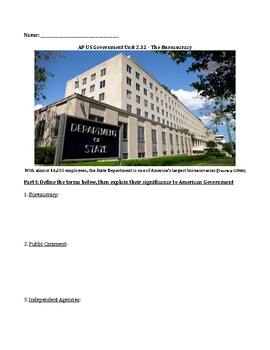
AP® US Government Unit 2.12 - The Federal Bureaucracy
Unit 2.12 of the AP® curriculum focuses on the federal bureaucracy, the so-called "Fourth Branch" of government.This nine-question ID/definition worksheet explores the vocabulary of Commissions, Agencies, Civil Servants, Government Corporations, "Iron Triangles" and more to help students better understand the role that unelected policymakers play in the day-to-day operation of US government. Special attention is also paid to reforms imposed on the Bureaucracy by the 1883 Pendleton Civil Service
Subjects:
Grades:
11th - 12th, Higher Education
Types:
Also included in: AP® US Government - Comprehensive Full-Year Accompanying Curriculum
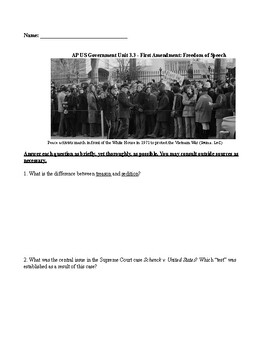
AP® US Government Unit 3.3 - First Amendment: Freedom of Speech
Unit 3.3 of the AP® curriculum devotes itself to Freedom of Speech, and how the protections guaranteed by the First Amendment have evolved over time.This nine-question short answer worksheet devotes itself to the many issues and controversies surrounding free expression in the United States. When does protected seditious speech become treasonous? What is the definition of obscenity? Are racism and hate speech protected by the Constitution? Included in this activity is a survey of speech-related
Subjects:
Grades:
11th - 12th, Higher Education
Types:
Also included in: AP® US Government - Comprehensive Full-Year Accompanying Curriculum
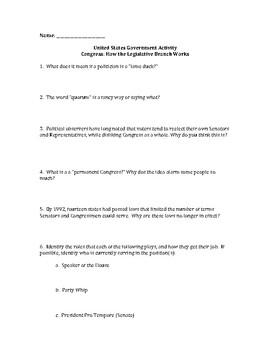
Congress: How the Legislative Branch Works
Congress remains one of the least trusted institutions in the United States - some surveys even rank its members behind used car salesmen in terms of reliability.This short answer / identification worksheet helps students understand why. Drawing its questions from various terms, issues and controversies involving the legislative branch. Why are there no Congressional term limits? Why are members of Congress regularly reelected if they are so unpopular? What does the Speaker of the House do?Perfe
Grades:
9th - 12th, Higher Education
Types:
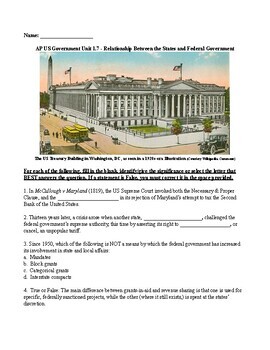
AP® US Govt Unit 1.7 - Relationship Between the States and Federal Government
Unit 1.7 of the AP® curriculum is devoted to questions surrounding the allocation of power in the US government, specifically: what is federalism, and why should we care? Where does federal power end and state power begin? And, perhaps most importantly, what role does money play in this whole process?This worksheet combines Fill in the Blank, Multiple Choice, True-False and Short Answer questions to demonstrate how society's needs impact the ever-changing balance of power between the federal an
Grades:
11th - 12th, Higher Education
Types:
Also included in: AP® US Government - Comprehensive Full-Year Accompanying Curriculum

AP US Government: Federalism in Focus – Mini Curriculum to Accompany Unit 1
What is federalism, and why should we care? Where does federal power end and state power begin? And, perhaps most importantly, what role does money play in this whole process?!"Federalism in Focus" is a forty--page mini-curriculum, written with these questions in mind. Whether you are teaching Civics, U.S. Government or preparing a Home School curriculum, this concise-yet-thorough lesson plan can help bring the subject alive for your students!Featuring photos, archival newsreel stills, and a ste
Subjects:
Grades:
7th - 12th, Higher Education, Adult Education, Staff
Types:

AP® US Government Units 3.2 & 3.3 - Is that Protected by the First Amendment?
Units 3.2 & 3.3 of the AP® curriculum examine how the First Amendment, together with the US federal court system, acts to protect Americans' Freedom of Religion & Freedom of Speech.This worksheet presents students with six situations where the boundaries between First Amendment protections and criminal conduct are unclear. Students must then use the Internet and/or their textbooks to look up relevant Supreme Court case precedents and establish for themselves: can tabloids print false st
Subjects:
Grades:
11th - 12th, Higher Education
Types:
Also included in: AP® US Government - Comprehensive Full-Year Accompanying Curriculum
Showing 1-24 of 29 results

